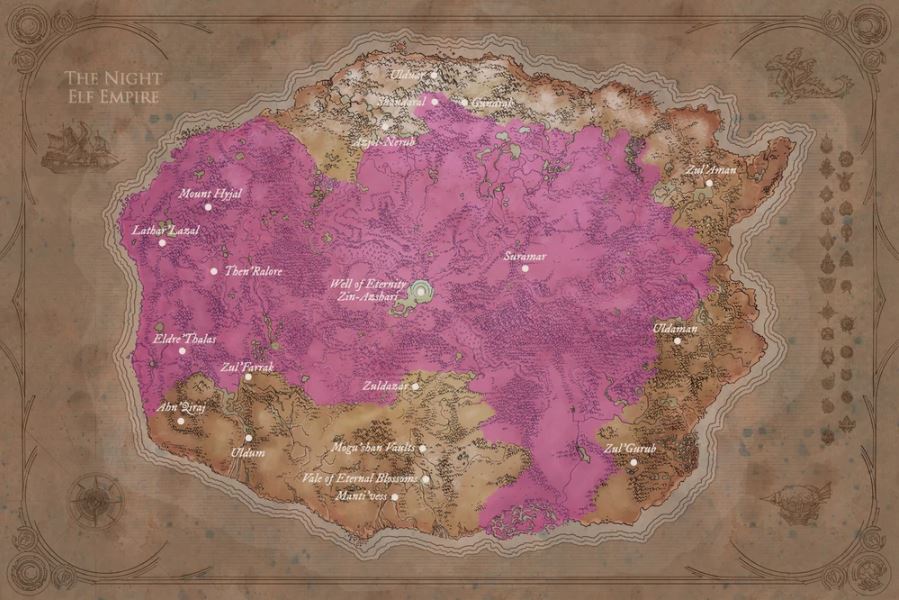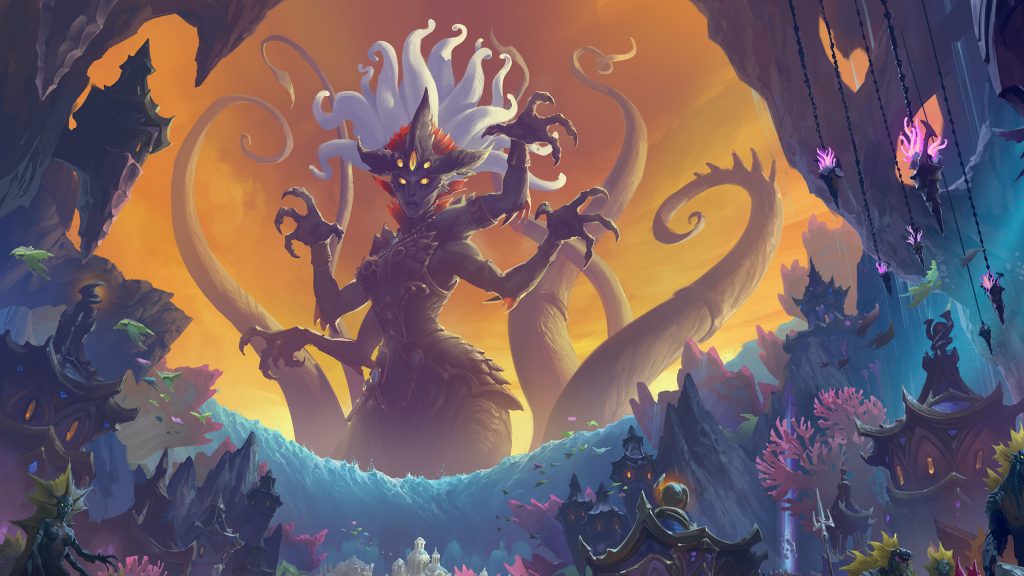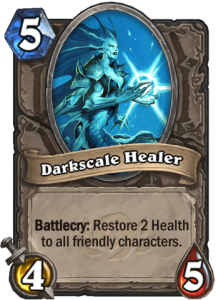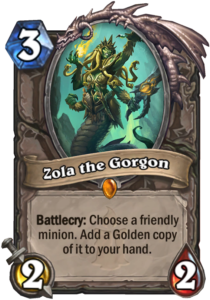The Hearthstone community is in somewhat of a limbo state: It’s April, and we still don’t know anything about the upcoming Standard year that is about to begin in just over a week. However, Blizzard has our backs when it comes to playable content of the intermediate future: On April 12, Hearthstone players will take a deep dive into the Voyage to the Sunken City expansion!
We accompany Ambassador Faelin and his entourage to explore the depths of the Great Sea – and what we will find has already been part of the recent card reveals: The Naga! Under the glorious reign of Queen Azshara, the Naga have left a substantial mark on Warcraft history. Without further ado and no intended puns, let’s dive into the history of the Naga culture, Queen Azshara’s character arc, and more!
Zin-Azshari – The Glory of Azshara
We have learned through the cinematic trailer that Ambassador Faelin, the Highborne night elf protagonist of the upcoming expansion, is on the search for a specific sunken city. In fact, Faelin’s flavor text tells us even more about the actual story:
For thousands of years, Faelin has longed to return to his homeland. Will Zin-Azshari be as he hopes, or are the secrets of the deep better left forgotten?
As we know now, the snooty and slightly overweight night elf is exploring the depths of the Great Sea to eventually find the capital of his people: Zin-Azshari. Faelin’s flavor text also hints at the golden glory of Queen Azshara’s territory being a beacon of power for millennia – it’s no wonder that the city’s name literally translates to “The Glory of Azshara”. We don’t yet know what are his plans after finding it, but I’m sure that we will find out soon enough – hopefully through some more PvE content (given that Book of Mercenaries is now over).
About ten thousand years ago, Zin-Azshari was the live-giving heart of the Kaldorei empire. Thanks to the power of the Well of Eternity, a source of eternal energy close to the capital provided by Azeroth itself, the night elves were to control arcane magic. Driven by curiosity and sheer power, the Kaldorei territory expanded quickly and eventually became the biggest empire that Azeroth had ever seen.

However, the power-hungry Queen Azshara and her Highborne kin, first and foremost Lord Xavius (yes, the same Xavius replacing Illidan on his Legendary card), tried to exploit the Well of Eternity even further. Their goal was to cleanse the world of everything except the Highborne, turning Azeroth into her perfect vision of an empire. What Azshara didn’t know at the time was that Xavius, her close counselor, had been tricked by Sargeras, the Fallen Titan and leader of the Burning Legion (a massive army of demons). The cunning titan wanted to siphon the power of the well, too – but only to summon his Burning Legion upon Azeroth. Eventually, Xavius begged his queen to listen to Azeroth’s ultimate enemy, and Sargeras and Azshara then forged a momentous pact: Giving Sargeras the benefit of the doubt, she helped him to establish a portal that enabled not only the very first invasion of the Burning Legion on Azeroth but also the so-called War of the Ancients.
In exchange, Azshara was promised her vision of a purified empire – but that was just a pipedream. Eventually, the Well of Eternity destabilized, causing a horrific explosion, known today as the Great Sundering. Zin-Azshari, due to its proximity to the well, was bound to be completely destroyed. However, Queen Azshara tried everything in her enormous power to save her people and their city.
This moment, the Great Sundering, – one of the most significant events in Warcraft lore – was visualized as part of the Warbringers series back during WoW’s Battle for Azeroth expansion. As seen through Azshara’s very own eyes, this piece is considered one of the best cinematics in the history of World of Warcraft, and I implore you to watch the full video:
As told by the Warbringers cinematic, Azshara was forced to make yet another pact with the dark side: N’Zoth, one of the Old Gods, made her an offer that she couldn’t reject.
Azshara and the Naga – Who are They?
When the Sundering happened, N'Zoth, The Corruptor, Ruler of the Black Empire, sensed an opportunity to escape from its eternal prison beneath the ocean. We don’t know if the Old God was pulling the strings that directly caused the War of the Ancients and the Great Sundering – not that it would’ve been of any meaning for Azshara. In exchange for her and the Highborne’s services, N’Zoth saved the queen and her people from certain death by turning them into ichthyic creatures – the Naga as we know them today had been born.

Upon the ruins of sunken Zin-Azshari, the Naga rebuilt their empire called Nazjatar, and from there on out, Azshara’s people have played an important part in Warcraft lore. The first Naga appeared back in Warcraft III, most notably Lady Vashj, Handmaiden of Queen Azshara. In the early years of World of Warcraft, the Naga have starred a fairly one-dimensional role. However, their image as chaotically evil fish people somewhat changed over the years. The main reason for that was the successful build-up of Queen Azshara as a major character in the history of Azeroth. Her story arc culminated in WoW’s Patch 8.2 called The Rise of Azshara where players found themselves in the middle of Nazjatar after Azshara had set up a trap against both opposing factions. The Battle for Azeroth, the expansion happening during Patch 8.2, was way more than just another faction conflict. In fact, this very patch unveiled many secrets of the Naga and, as a result, a lot of information about the Old Gods that they’ve worshipped ever since the Great Sundering.
It was only after the raid finale of the Eternal Palace where players fought against Queen Azshara that we have learned what Azshara really had in mind: She wanted to kill N’Zoth by herself to free her people from the deal she made with the Corruptor. As a result, the Old captured the Naga queen and tortured her for what was meant to be an eternity. Azeroth’s adventurers intervened yet again and freed Azshara; in return, she gave them the mighty dagger Xal’atath to destroy N’Zoth. Right after, Azshara escaped through a void portal and was never seen again since. Sometime later, Wrathion used the dagger to crack N’zoth’s carapace, opening up the way to eventually defeat the Old God together with the Azerothian adventurers during the expansion finale of Battle for Azeroth.
The Naga in Hearthstone – A Welcome Addition
Now back to Hearthstone: Timeline wise, we do not know if the upcoming expansion will happen before or after the happenings of Battle for Azeroth. The Naga queen is still missing, and I love the thought that the Hearthstone universe provides a few solid hints regarding her whereabouts in official Warcraft lore.
Following the general theme of Azshara’s character arc over the last 20 years, all we could offer on our side of the deal is to accept the mighty Naga as a Hearthstone minion type! As if that wasn’t bound to happen at some point in history, anyway. The Naga have been a part of Hearthstone’s cultural line-up since its release, but they weren’t particularly common. A Naga-centric expansion has been a fan favorite amongst multiple Blizzard game communities, and it’s great to see Team 5 showcasing their own twist to the sunken Naga empire!



Thank you. Is nice to have some lore to build hype over. I loved the story books of the last expansion, and with a possible inclusion of our explorers in the core set, they could take part of this year storytelling too. Maybe not as three linear themed expansions, but as the actual whereabouts of some of our explorers. I love it.